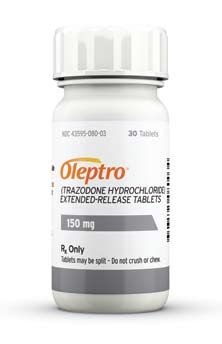Labopharm Inc's Oleptro
The FDA approved Labopharm's Oleptro (trazodone hydrochloride) extended-release tablets for treatment of major depressive disorder in adults.

On February 3, 2010, the FDA approved Labopharm Inc’s Oleptro (trazodone hydrochloride) for treatment of major depressive disorder (MDD) in adults. MDD, a common mental illness affecting more than 14 million US adults, is often characterized by a combination of social and somatic symptoms. Oleptro is an extended-release form of trazodone given once daily.1
MECHANISM OF ACTION
Although the mechanism of action of Oleptro is not fully understood, it is thought to exert its effects by selectively inhibiting the neuronal reuptake of serotonin, and also by antagonizing the 5-HT 2A/2C serotonin receptors.2
Oleptro is well absorbed after oral administration and is primarily metabolized in the liver by cytochrome P450 3A4 to an active metabolite. Oleptro is highly protein bound (85%-95% in vitro), andis predominantly excreted in the kidneys. The mean terminal half-life after a 300-mg single dose of Oleptro is 10 hours.2
CLINICAL TRIALS
A double-blind study was conducted with 412 patients with MDD in which they were randomized 1:1 to receive Oleptro (150-375 mg) or placebo oncedaily. The doses were optimizedduring the first 2 weeks of therapy, and then continued for 6 weeks.3
The mean maximum daily dose was 310 mg for the active group and 355 mg for the placebo group starting at the end of the 2-week optimization period and ending at the completion of the 6-week duration of therapy. Based on the primary endpoint, a changein the 17-Item Hamilton Depression Rating Scale (HAMD-17) from baseline to last study visit, there was a statistically significant difference between Oleptro and placebo on the mean HAMD-17 score (-11.4 vs -9.3; P = .012).3 The outcome was that the extended-release formulation of trazodone was more effective in treating patients with MDD than placebo. Headache and somnolence were the most commonly reported adverse effects for both the active and placebo groups.
DOSAGE/ADMINISTRATION
Oleptro is available in 150- and 300-mg scored tablets. The recommended initial dose is 150 mg once daily. The dose may be increased to 75 mg per day every 3 days, with a maximum daily dose of 375 mg per day.2
Oleptro should be taken at the same time every day, preferably at bedtime due to potential for drowsiness or dizziness. The tablets are not to be crushed or chewed, but broken at the scored line if a partial dose is needed.2 If therapy is to be discontinued, a gradual decrease in dose is recommended.
WARNINGS/PRECAUTIONS
Oleptro should not be taken concomitantly with monoamine oxidase inhibitors (MAOIs). A 14-day period must pass after the MAOI is discontinued to start Oleptro therapy. Oleptroshould not be given to patients during the initial recovery from a myocardial infarction.2
Oleptro can cause QT prolongation, orthostatic hypotension, serotonin syndrome, hyponatremia, and priapism. There is potential risk for bleeding when Oleptro is taken with aspirin, nonsteroidal antiinflammatory drugs, or other medications that may affect coagulation.2
Oleptro is pregnancy category C and should be used with caution during breastfeeding.2 As with all antidepressants, Oleptro therapy should be monitored closely in patients with MDD at risk for suicide or who have suicidal tendencies.2
References:
1. Labopharm Receives FDA Approval For Oleptro [Press Release]. www.prnewswire.com/news-releases/labopharm-receives-fda-approval-for-oleptrotm-83429037.html.
2. Oleptro Package Insert; Labopharm Europe Limited June 2010
3. Sheehan DV, Croft HA, Gossen ER, Levitt RJ, Brullé C, Bouchard S, Rozova A.; Extended-release Trazodone in Major Depressive Disorder: A Randomized, Double-blind, Placebo-controlled Study. Psychiatry (Edgmont). 2009 May;6(5):20-33.
Both Ms. Belisle and Dr. Patel are pharmacists at Brigham and Women’s Hospital, Boston, Massachusetts.

